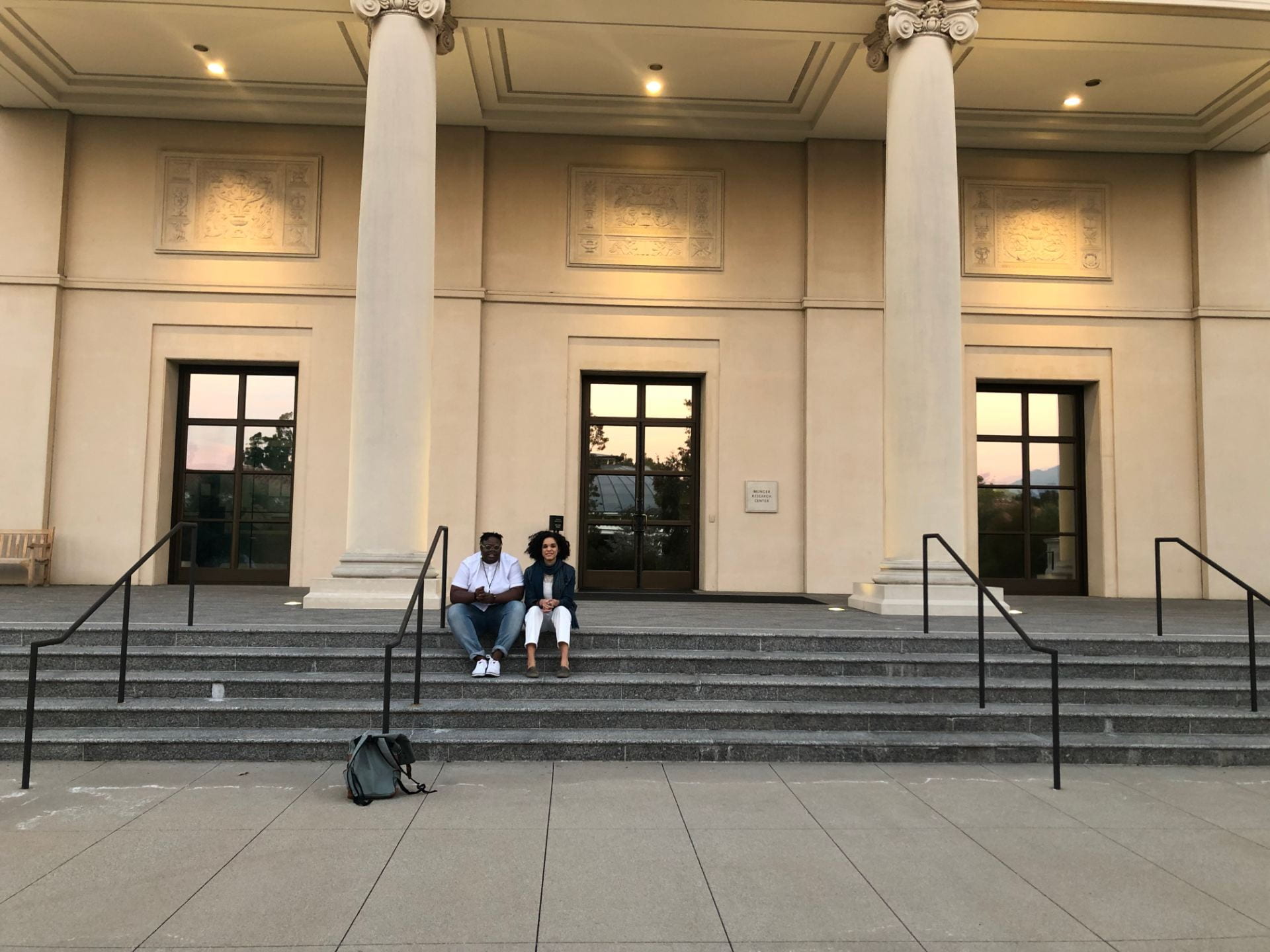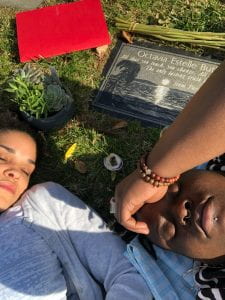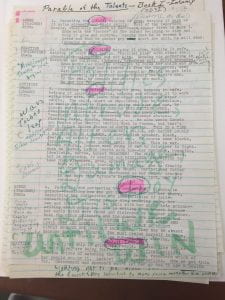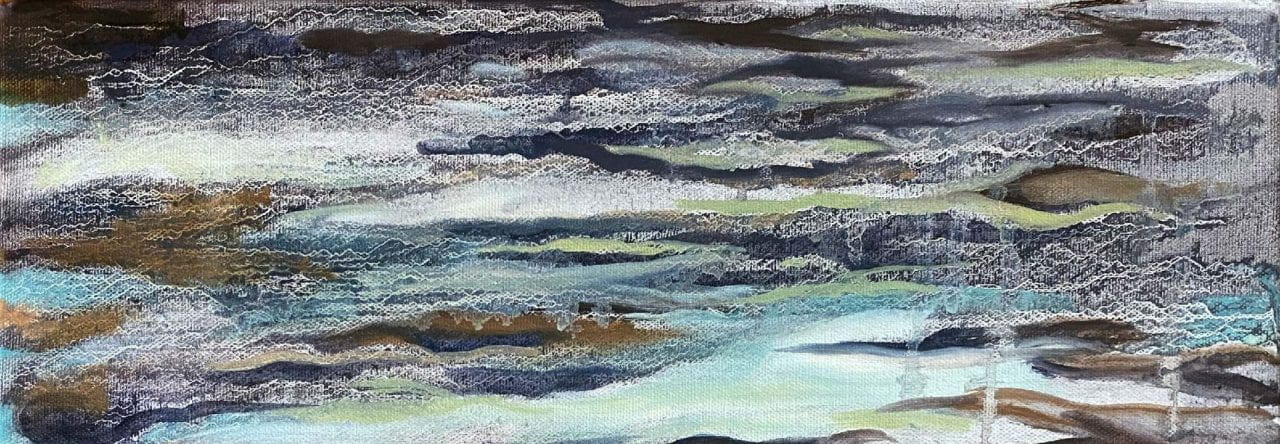“All that you touch, you change. All that you change, changes you. The only lasting truth is change. God Is Change.” – Octavia Estelle Butler Memorial Epitaph, 1947-2006

Dara and Porsha outside of the The Huntington Library, Art Museum, and Botanical Gardens
2020, in its early months, has proven itself to be an uncertain year. One of the most grounding experiences, on the contrary however, is the time we spent together sprawled on a blanket at a beach in southern California. We sat witnessing the sun turn from our side of the globe for the evening. What a reassuring and peaceful calm it felt to be near water and reflecting. We had just come from spending the afternoon finishing tacos and sitting at the memorial site of Octavia Estelle Butler. Dara brought succulents and a candle and Porsha brought sunflowers. We lay there thinking of Butler, ancestry, and legacy. Is life’s culmination the reciprocal relationship of touching and changing ourselves and others? After we have passed do we live on through our impact? Here we were, at the cusp of so many thoughts and places, the edge of the country, the spin of a new day, a meeting yard of life and life past.

Writer and artist, Porsha and Dara lay at the gravesite of Octavia Estelle Butler after visiting the archives, January 5, 2020 (Photo by Dara Kwayera Imani Bayer)
Two days before we entered Butler’s archives at the Huntington Library completely unaware of what to expect but eager for the opportunity to pour over the contents of the archive. We took special care in learning which, among the nearly 400 boxes, we wanted, and then how to request those boxes. Though the website contained a description, each box’s content was a surprise. Starting together we spent our first hour in the archive pouring over photos of Octavia Butler or photos Butler had taken: landscape, colleagues at writing festivals, a plethora of elaborate plants and landscapes. In our own separate inquiry, we each began a journey through Butler’s archives. In addition to photos, we explored intimate manuscripts (some complete and published, others unfinished drafts), research material, journal entries, old posters, interviews, birthday cards and whatever else one can imagine keepsaking over the years. We both found ourselves, however, somewhere embedded in the verses of “Earthseed: The Books of the Living.” Earthseed is a religion created and practiced by one of Butler’s most prodological protagonists, Lauren Oya Olamina. Lauren, a character inspired by both the Yoruba Orisha, Oya, and Octavia Butler’s own grandmother, is a teenage girl who deviates from her father’s christianity to form her own religious practice and community. Earthseed is a religion that embraces shaping change and investing in the living. In an interview found in the archives, Octavia Butler states “I wanted to create a religion I could believe in.” And how powerful is that, to write and share a philosophy one can believe in. This creation of a belief system is what served as a muse and guide for us. What would it look like then, literary and visually, if we mapped the cartography of our own religion.

Preparatory notes on Butler’s unfinished manuscript, Parable of the Talents, wherein she explores cycles of social evolution. (Photo by Dara Kwayera Imani Bayer.)
Teacher, Trickster, Chaos, Clay. This progression of words shows up in Butler’s writing over and over again. They are metaphors for the concept of “God as Change” in the Earthseed verses. Scribbled as notes, they become archetypal descriptors in the unpublished Parable of the Trickster. They represent different ages and stages of collective/societal development, both past and future. They are the title of a memoir fragment about Butler’s relationship to writing—both her love and obsession with her craft. The repetition of these words seems to be cyclical and iterative, a vehicle to reach greater creative insights and deeper understandings of humanity’s possibility for positive transformation as well as its capacity for destruction and devastation.
In observing Butler’s obsession with cycles, her searching, unpacking, unpeeling, engaging with her reality and its relationship to the future worlds she was building in her work, we began to explore our own relationship to cycles. We asked ourselves how we moved through our process of inner development and transformation, as well as how we were moving through our relationship with Butler’s work. In our discussions during our time together in Pasadena and then after, four dimensions of a pattern of evolution, initiation, and consciousness emerged: reflection / abyss / vision / legacy. These four themes/dimensions are not linear and can be understood as existing in a cyclical way; they do, however, carry a progression, which has animated our process of creation and collaboration for this exhibition.
Reflection emerged as the process of situating self on a continuum of existence, of seeing where we have been in our lifetime and in our lineage, as a way to inform where we will go—the practice of Sankofa. Our experiences with each other and at the archives were anchored in our subjectivity as people of Afrikan descent with overlapping, as well as, very different lineages. Our identities as artists, and all that has shaped our creative practice, informed our relationship to Butler’s writings and images.
From the place of reflection comes a widening awareness of the world and the inner and outer landscape, a process of looking down into the abyss. This broadening and deepening of awareness can be overwhelming, yet it is the essential ingredient for responding to our external conditions and our conditioning. With a sober understanding of an ugly reality, we think of abyss as a crossroads, a recognition and questioning of many possibilities. This was Lauren Olamina’s orientation to life, her steadfast vision of “God as Change,” that called for adaptation and foresight, what her father described as “[noticing] the abyss.”
With looking down into the abyss, both a terrifying and luminous space, we come into our vision: the consciousness we need to shape our experience, to “shape God.” Our visions are rooted in the interdependence of the collective and in the possibility for something to grow and evolve amidst the fiery destruction. Vision recognizes and holds all the complexity of our existence while shining a way forward. Lauren’s founding of Acorn, the first Earthseed community at the end of Parable of the Sower, is a powerful reference point for how we can find ways to honor those we’ve lost while also co-creating something new, rooted in care and love. Perhaps most importantly, vision is not static, but a spiraling force that guides us across space and time to continually help us see within and beyond the abyss.
In manifesting our vision, we birth a legacy—that which we leave behind for those who come after us to reflect upon, grapple with, and further evolve. Butler possessed a powerful foresight about the significance of her work; she kept all of her notes and ensured that they were kept in a secure place, amidst the resilient succulents at the Huntington archives. What are the pieces of ourselves that we want others to hold, nurture, and grow long after we have departed this physical plane? What kind of ancestors do we want to be for future generations?
It is this question that we pondered at Butler’s memorial, our humble offerings of succulents, sunflowers, and sage framing her grave stone. We sat with our hearts overflowing with gratitude for this powerful being who graced us with her imagination, insight, stories, raw determination and obsession. Butler’s reflections, her journeys into the abyss, her profound manifested visions and her legacy, have materialized in our consciousness and in our bodies. This experience of legacy, of being in sacred space and relationship with each other through a shared reverence for Butler’s contributions, led us to invite you, those who choose to engage with our creative work, into conversation. We wanted this exhibition, a collection of poetry and paintings, to also include an altar as an invitation for our broader communities to consider their spirals, their contributions, their legacies. Butler would never have wanted an altar that focused on her; her writings and notes warn against the obsession with the individual and the psychology of the cult. However, we could imagine honoring her by creating a sacred space for possibility, the consciousness that leads to questions and visions beyond our current reality.
We are in a moment of profound uncertainty and in an age where the conditions have upended the status quo. Butler’s questions can be a guiding light in this time of the abyss. How will we emerge from the current chrysalis in our collective spiral? How will you participate in this movement? What will you share and leave for others as part of your calling?
Porsha Olayiwola
2020 Heimark Artist in Residence
Dara Kwayera Imani Bayer
2020 CSSJ Visiting Artist
May 2020
